The Solaris Print Client-Server Process
This section provides an overview of the print client-server process.
Using Print Servers
The print server is a system that has a local printer connected
to it and makes the printer available to other systems on the network.
The following figure highlights the part of the print process in which the
print server sends the print request to the printer.
Figure 1-1 The Print Server Sends a Print Request to the Printer

The print client submits a print request.
The print request is processed on the print client.
The print request goes to the print server.
The print request goes to the printer.
The print output is produced on the printer.
Using Print Clients
A print client is a system that can send print requests to a
print server.
The following figure highlights the part of the print process in which the
user submits a print request from a print client.
Figure 1-2 The User Submits a Print Request from a Print Client

The Print Client Process
The following figure illustrates the path of a print request from the time
the user initiates the request until the print request is printed.
Figure 1-3 Overview of the Print Client Process

A user submits a print request from a print client.
The print command checks a hierarchy of print configuration resources to determine where to send the print request.
The print command sends the print request directly to the appropriate print server. A print server can be any server that accepts Berkley Software Distribution (BSD) printing protocol, including System V Release 4 (SVR4), or LP print servers and BSD LPD-based print servers, as well as servers that accept IPP.
The print server sends the print request to the appropriate printer.
The print request is printed.
How Local Printing Works
The print request follows the same path it would if the client and
server were separate systems. Requests always flow from client to server following the
same path.
The following figure shows what happens when a user submits a request to
print a PostScript file on a local printer, which is a printer connected
to the user's system. The lpsched daemon on the local system does all
processing.
This processing might include the following:
Matching the printer and content type
Identifying the default printer, filtering the request
Starting the specified printer interface program
The printer interface program does the following:
Prints the banner page.
Catches printer faults.
Determines the printer fault policy to either reset, continue, or begin the print job over again.
Finally, the interface program uses the lpcat program to download the print request to the local printer's serial port.
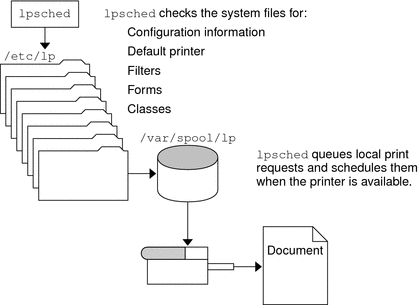
How LP Administers Files and Schedules Local Print Requests
The LP print service has a scheduler daemon called lpsched. The scheduler daemon
updates the LP system files with information about printer setup and configuration.
The lpsched daemon schedules all local print requests on a print server, as
shown in the following figure. Users can issue the requests from an application
or from the command line. Also, the scheduler tracks the status of printers
and filters on the print server. When a printer finishes a request, the
scheduler schedules the next request n the queue on the print server, if
a next request exists.
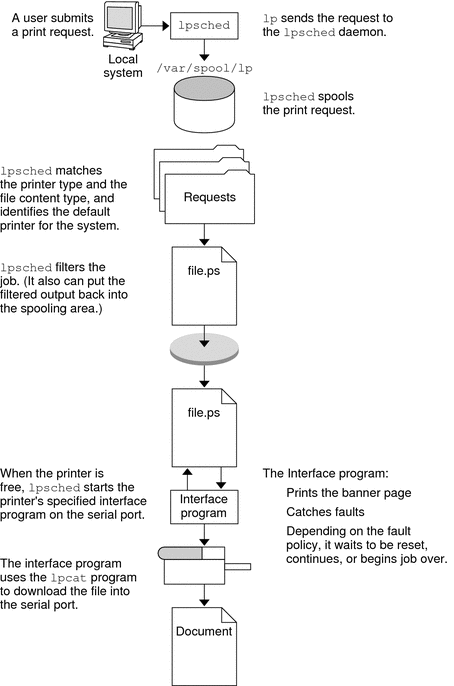
Without rebooting the system, you can stop the scheduler with the svcadm disable application/print/server
command. Then, restart the scheduler with the svcadm enable application/print/server command. The scheduler for each system
manages requests that are issued to the system by the lp command.
How Remote Printing Works
The following figure shows what happens when a user on a Solaris
print client submits a print request to an LPD-based print server. The command
opens a connection and handles its own communications with the print server directly.
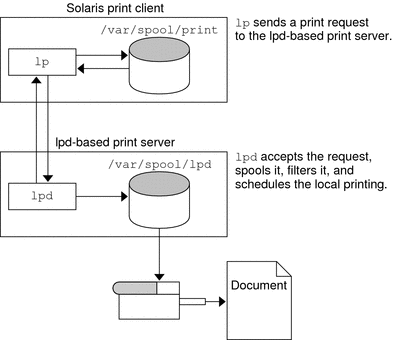
The following figure shows an LPD-based print client submitting a print request to
a Solaris print server. The lpd daemon handles the local part of the
print request and the connection to the print server. On the print server,
the inetd process waits for network printing requests and starts a protocol adaptor
to service the request. The protocol adaptor communicates with the lpsched daemon, which processes
the request on the print server.
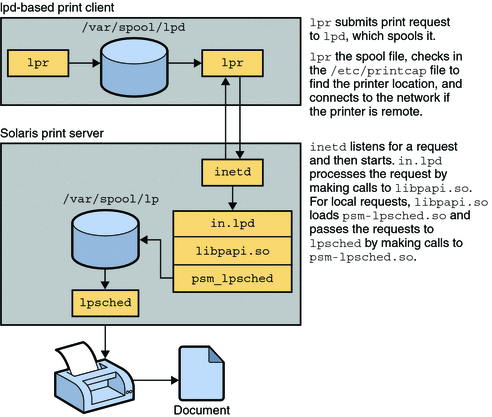
The following figure shows what happens when a user on a Solaris
print client submits a print request to a Solaris print server. The print
command on the print client handles the local part of each print request
by communicating directly with the print server.
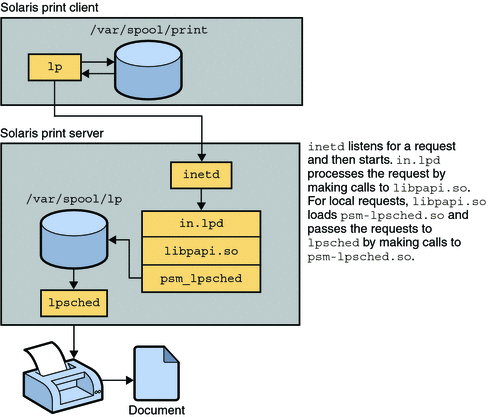
The inetd process on the print server monitors network printing requests and starts
a protocol adaptor to communicate with the lpsched daemon on the print server, which
processes the print request.
